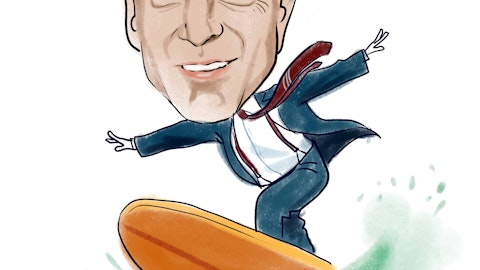Argosy Investors, an investment management firm, published its fourth-quarter 2021 investor letter – a copy of which can be seen here. The fund’s 2021 performance was 24.3% in select accounts. The S&P 500 by comparison returned 28.7%. Argosy Investors ended the year with 33% of its portfolio in cash and equivalents and dipped as low as 15% at the end of the 2nd quarter last year. Otherwise, cash hovered between 25-35% of the total account value for the fund. Spare some time to check the fund’s top 5 holdings to have a clue about their top bets for 2022.
Argosy Investors, in its Q4 2021 investor letter, mentioned Leslie’s, Inc. (NASDAQ: LESL) and discussed its stance on the firm. Founded in 1963, Leslie’s, Inc. is a Phoenix, Arizona-based swimming pool supplies retail company with a $3.8 billion market capitalization, and is currently spearheaded by its CEO, Michael Egeck. LESL delivered a -11.58% return since the beginning of the year, while its 12-month returns are down by -13.23%. The stock closed at $20.92 per share on March 08, 2022.
Here is what Argosy Investors has to say about Leslie’s, Inc. in its Q4 2021 investor letter:
“Leslie’s (LESL) may not be a name you’re familiar with, but they are the largest Direct-to-Consumer (DTC) distributor of pool-related supplies, with over 900 locations nationwide and the largest organic online traffic of any direct competitor. Like any retailer, particularly one focused on the home, they face some competition from Home Depot/Lowe’s and online from Amazon.com. Pool care is a very service-based business, which is why pool supplies have historically been somewhat more insulated from these large competitors, at least so far.
When I think about LESL’s attractiveness as an investment, the slide below has a lot to do with it. Leslie’s is clearly fairly resilient to economic pressures, with sales growth during each of the last 3 recessions.Why are they able to generate such consistent sales growth? From a high level, once a pool is installed, it generates decades worth of annual, non-discretionary maintenance expenses without which a pool deteriorates and requires significant capital investment.
An unusable pool destroys significant real estate value, so any homeowner with a pool is highly incentivized to maintain their investment. Speaking of pool owners, their average income ranges between $50-150,000, averaging well above the typical American household. In other words, the pool owner customer base tends to skew wealthier and likely more resilient to economic shocks.
During the pandemic, almost all of us were stuck at home. As you can see from the chart below, many people elected to build pools, and future years are expected to see over 100,000 pools installed per year. This increase in pool construction represents a multi-decade increase in the revenue potential for LESL and its competitors. I look forward to many years of mid-single digit or better revenue growth and double-digit increases in earnings, if management is correct about the opportunity.
LESL is not especially cheap, at ~20x 2022 Free Cash Flow, but I believe the roughly market multiple valuation does not reflect the quality of the business, which earns a >50% unlevered return on tangible capital. The substantial returns the business generates should enable LESL to return significant capital to shareholders via dividends and/or stock repurchases.”

Pixabay/Public Domain
Our calculations show that Leslie’s, Inc. (NASDAQ: LESL) failed to obtain a mark on our list of the 30 Most Popular Stocks Among Hedge Funds. LESL was in 28 hedge fund portfolios at the end of the fourth quarter of 2021, compared to 31 funds in the previous quarter. Leslie’s, Inc. (NASDAQ: LESL) delivered a -4.87% return in the past 3 months.
In September 2021, we published an article that includes LESL in the 15 Best Seasonal Stocks to Buy Now. You can find more than 100 investor letters from hedge funds and prominent investors on our hedge fund investor letters 2021 Q4 page.
Disclosure: None. This article is originally published at Insider Monkey.





